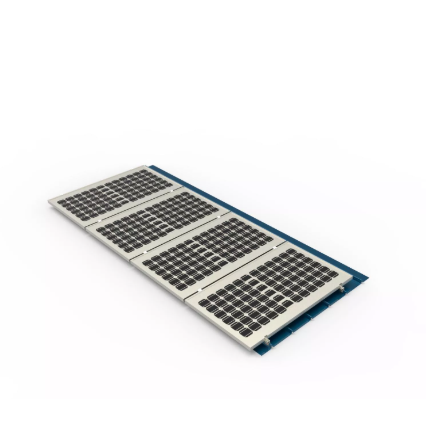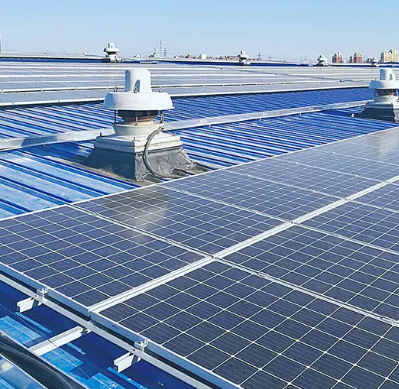


Views: 0 Author: Site Editor Publish Time: 2025-09-11 Origin: Site








Are you choosing the right solar panelfor your energy needs? With so many options available, it's crucial to understand the difference between monofacial and bifacial solar panels.In this post, we’ll explore the benefits, efficiency, and applications of both panel types. You’ll learn which one suits your needs best for optimal performance and cost-efficiency.

Monofacial solar panels are the most common type of solar panel. They absorb sunlight from one side— the front—where solar cells are located. These panels are designed to convert sunlight into energy only from this single side.
Monofacial panels capture sunlight from the front. The sunlight hits the photovoltaic (PV) cells, converting it into direct current (DC) electricity. An inverter then changes this DC into alternating current (AC) for home or business use.
Monofacial panels are widely used in:
Residential rooftops: Ideal for homeowners looking to reduce energy bills.
Small ground-mounted systems: Great for areas with limited space or smaller energy needs.
Cost-effective: Their simpler design makes them more affordable than bifacial panels.
Easier to install: The lightweight structure allows for quicker and less complex installation.
Bifacial solar panels are designed to absorb sunlight from both sides—front and back. This ability allows them to capture light reflected off the ground or other surfaces, boosting their overall energy output.
These panels have photovoltaic cells on both the front and back, which helps collect sunlight from multiple directions. The transparent backsheet or frameless design allows light to pass through and be absorbed by the back cells, enhancing energy production.
Bifacial solar panels are ideal for:
Commercial and industrial installations: Great for large-scale energy production.
Utility-scale solar farms: Best used in open areas with high reflection potential, such as snowy fields or rooftops.
Ground-mounted systems: Particularly effective when elevated to capture reflected light.
Enhanced efficiency: They generate more electricity by using light reflected off surfaces like snow, water, or light-colored roofs.
Durability: With tempered glass on both sides, these panels are more resistant to environmental conditions like high temperatures or harsh weather.
Better performance in diffused light: Bifacial panels perform better than monofacial ones in cloudy or shaded conditions, as they can capture reflected light.
Monofacial: One Side Only
Monofacial panels absorb sunlight only from the front, limiting their energy production to direct sunlight hitting the panel.
Bifacial: Both Sides
Bifacial panels can absorb sunlight from both the front and the back, making them more efficient by capturing light reflected off surfaces like the ground or nearby structures.
Monofacial: Opaque Backsheet
Monofacial panels have an opaque backsheet that prevents light from reaching the back of the panel, ensuring the energy conversion happens only on the front side.
Bifacial: Transparent or Frameless
The backsheet of bifacial panels is either transparent or frameless, allowing light to pass through and be absorbed by the back of the panel, which boosts energy output.
Monofacial: Limited to Direct Sunlight
These panels generate energy solely from the sunlight hitting the front side, making their efficiency dependent on direct sunlight exposure.
Bifacial: Higher Efficiency with Reflected Light
Bifacial panels capture both direct and reflected sunlight, potentially increasing their efficiency by up to 30%, especially when installed on reflective surfaces.
Monofacial: More Cost-Effective
Monofacial panels are generally cheaper due to their simpler design and manufacturing process, making them a budget-friendly option.
Bifacial: Higher Initial Cost
The added complexity of bifacial panels results in a higher initial cost, but their increased efficiency can lead to better long-term returns on investment.
Monofacial: Easier Installation
Monofacial panels are lighter and more flexible, making them easier and less expensive to install, especially on rooftops or in small-scale residential setups.
Bifacial: Requires Specialized Mounting
To optimize the benefits of bifacial panels, special mounting systems are needed to ensure the panels are positioned to capture reflected light effectively.
When deciding between monofacial and bifacial panels, it’s important to think about your specific needs. Key factors include:
Environmental Conditions: Consider your local climate and how much sunlight your area receives. Reflective surfaces like snow, water, or light-colored ground can make bifacial panels more effective.
Solar Exposure: If your property gets a lot of direct sunlight, monofacial panels might be enough. But if you have space that gets reflected light, bifacial panels could offer higher returns.
Upfront Costs vs. Long-Term Savings: Monofacial panels are less expensive upfront, making them a great choice for tight budgets. However, bifacial panels, though pricier, can save you more in the long run due to their higher efficiency.
Best Choices for Different Budgets: If you're on a budget, monofacial panels might be the better option. But for long-term energy production and savings, consider investing in bifacial panels if you have the upfront capital.
Bifacial Panels: Ideal for commercial and utility-scale installations. They perform best in open areas where light can be reflected onto both sides, such as rooftops, ground-mounted systems, or snowy regions.
Monofacial Panels: Great for residential settings or areas where installation space is limited. These panels are easier to install and work well in environments with consistent direct sunlight.
For homeowners, monofacial solar panels are a popular choice due to their affordability and simplicity. They work well on residential rooftops where space is limited, and they are easier to install.
Pros:
Lower upfront costs, making them ideal for budget-conscious homeowners.
Easier and faster installation, reducing labor costs.
Ideal for areas with consistent direct sunlight.
Cons:
Limited to sunlight absorption from the front side, reducing overall efficiency.
May not take full advantage of reflective surfaces or unique environments.
Bifacial panels are better suited for large-scale setups like solar farms or commercial properties. Their ability to absorb light from both sides makes them more efficient in open spaces or areas with reflective surfaces.
Why They Are Ideal for Commercial and Utility Installations:
Higher efficiency: They capture both direct and reflected sunlight, increasing energy production.
Best for large spaces: Their performance improves when installed on elevated ground or areas with significant reflection, like rooftops with snow or light-colored surfaces.
Durability: Tempered glass on both sides makes them more resilient to environmental factors, an important consideration for large installations.

Bifacial solar panels perform best in environments where light is reflected onto both sides of the panel. Reflective surfaces, such as snow, water, or white roofs, increase the amount of sunlight the panel absorbs, enhancing overall efficiency.
Snow: Snow reflects sunlight well, especially in colder climates, boosting energy generation.
Water: Pools or bodies of water can reflect a significant amount of sunlight, helping increase panel performance.
White Roofs: Roofs painted white or made from reflective materials can reflect light onto the backside of the panels, improving their efficiency.
Shading can significantly impact the performance of solar panels, but bifacial panels still have an edge over monofacial panels in these conditions.
Bifacial Panels: While they still depend on direct sunlight, bifacial panels can capture reflected light from surrounding areas, slightly reducing the loss of energy due to shading.
Monofacial Panels: These panels only capture light from the front, so shading on the panel can reduce their energy production much more significantly.
As solar technology continues to advance, bifacial panels are becoming more popular. Manufacturers are finding ways to reduce production costs, making these panels more accessible and cost-effective. As a result, bifacial panels are expected to become a standard option in the industry, especially for large-scale installations. Their higher efficiency and ability to generate more energy make them an appealing choice for both residential and commercial uses.
Cost Reductions: Technological advancements are making bifacial panels cheaper to produce, allowing for a better return on investment.
Efficiency Improvements: Ongoing research continues to improve their energy conversion rates, making them more effective in different environments.
Government policies and industry incentives play a crucial role in encouraging the adoption of new solar technologies. Many countries are offering incentives for solar installations, including tax credits or subsidies, to support the transition to more sustainable energy sources. Bifacial solar panels, with their higher efficiency, align well with the global push for cleaner energy and can be supported through these incentives.
Government Policies: Tax incentives and grants for renewable energy projects are driving interest in bifacial technology.
Industry Support: Solar panel manufacturers are increasingly focusing on bifacial technology, pushing the industry toward wider adoption.
Monofacial panels are cost-effective and easier to install, while bifacial panels offer higher efficiency and performance.
Consider your budget, energy needs, and installation environment before deciding on the right solar panel type for you.
A: Bifacial panels are more efficient as they capture both direct and reflected sunlight, increasing energy production.
A: Yes, bifacial panels tend to be more expensive due to their complex design and dual-sided energy absorption.
A: Bifacial panels can produce up to 30% more energy, depending on reflective surfaces and environmental conditions.
A: Yes, but bifacial panels perform best with reflective surfaces. They may not be the most efficient for typical rooftops.
A: Both types typically last 25 to 30 years, with bifacial panels often having longer warranties due to their durability.